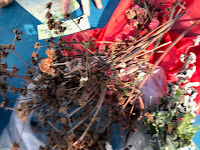On November 27, Ms. Yoshida's students looked at the compost bags at they'd made two weeks before and saw some changes. The apple was mushy and orange inside, the grass and leaves were soft, the membrane of the egg shell was more visible, the cardboard was thinner and softer and the paper had disintegrated a bit. The screw and plastic bag piece had not changed. We'll discuss later why the screw and plastic bag aren't decomposing.
We'll check in on the bags in two more weeks to see how much more rot and decomposition we see. This is what happens in a worm bin, but the worms help with the decomposition.
The kids looked at our new worms and enjoyed seeing them move. They put them back in the compost bin with some clean vegetable scraps from our salad. They also watered the bin. The contents of the bin need to be moist like a sponge.
The children enjoyed a salad with lettuce, corn, carrots sugar snap peas and broccoli. They love salad!






